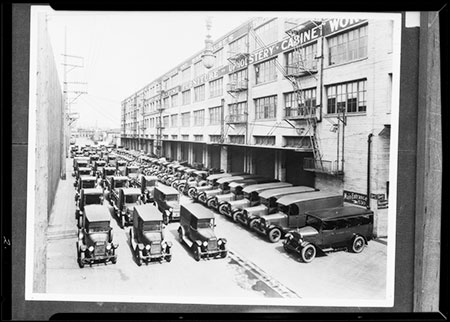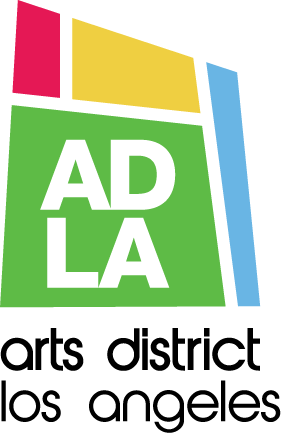The Arts District, roughly bounded by Alameda, the Los Angeles River, the 101 Freeway and the 10 Freeway, is known to many as the creative and cultural hub of Los Angeles. Since the City’s founding, this area of Los Angeles has always played a vital role in the region. With the influx of new businesses, residential developments and the rebirth of older industrial buildings, the Arts District is helping reshape Los Angeles from a sprawled metropolis into a city with a thriving urban core.
Founding of a City
In 1769, during a Spanish expedition into Alta California, Father Juan Crespi noted an inland location with a small river, with water in the summer and good soil. He suggested in his diary that should a town be needed in the area, this was a good choice and he named the site: Our Lady, Queen of the Angels. El Pueblo de Nuestra Señora, La Reina de Los Angeles de Prciúncula was founded as a city on September 4, 1781.
From Grapevines to Rail Roads
In 1883, French winemaker Jean-Louis Vignes brought the first European vines from his native Bordeaux, where he planted them in Downtown Los Angeles and built a winery. In 1851, an Irish immigrant, Matthew Keller or Don Mateo, opened a general merchandise store at the corner of Los Angeles and Commercial Streets. He soon joined Vignes in growing wine grapes after purchasing property on Alameda and Aliso Street, at present-day Union Station. Had you visited this area in the mid nineteenth-century, you would have seen acres of vineyards. Other winemakers and fruit growers followed Vignes & Mateo and by the late nineteenth century, oranges and grapefruit had outpaced grapes as the primary product of the area. Railroads and manufacturing soon emerged to serve the citrus industry’s shipping needs, and later to support the large number of people moving into California, and so began the transportation and industrial chapter in this neighborhood’s history.

Industrial Boom
In 1876 the Southern Pacific Railroad arrived in Los Angeles, followed by the Southern Pacific, the Atchison, Topeka, Santa Fe Railroad and finally the Union Pacific. By 1905 Los Angeles had become the western terminus for three major transcontinental railroads. All three railroads built depots, transportation buildings, warehouses, and rail yards in and around the Arts District.
In fact, many of the industrial buildings constructed in the Arts District during the late nineteenth and early twentieth century leave clear signs that they were built around the railroad.
Infrastructure for the railroads and other industrial uses were beginning to erode the agricultural and working-class residential neighborhoods marking a clear path toward industrialization during the twentieth century. Key manufacturers located in the Arts District at this time were producing bakery products, women’s clothing, foundry and machinery goods, furniture, printing and publishing materials, automobile parts, and rubber. In 1922 the city had officially re-zoned downtown to eliminate all residential housing in order to make room for more offices, retail, and manufacturing. This move solidified the Arts District as an industrial center. Manufacturers continued to locate in the area throughout the 1910s and 1920s.
By the end of World War II, industrial needs began to evolve. Railroads gave way to the trucking industry, large trucks had difficulty accessing some of the smaller streets that were once railroad spurs. Manufacturing plants grew larger in size, yet land parcelsin the neighborhood were small. Companies had to purchase several adjacent lots in order to build a large plant, making property acquisition difficult. Newer, outlying cities such as Vernon and the City of Commerce could better accommodate the needs of modern industries.
As companies moved away to build larger, more modern factories, the warehouses of the Arts District stood vacant and the neighborhood began to decay.

Enter Artists
In the 1970s a group of artists, many of whom were bring priced out of the increasingly expensive Venice and Hollywood art scenes, saw opportunity in the forgotten buildings Downtown, east of Alameda. Vacant warehouses made for massive live/work studios at rock-bottom prices.
The artists opend up a number of avant-garde art galleries, such as the Los Angeles Contemporary Exhibitions (LACE) center on Industrial Street, and The Art Dock, a drive-by street gallery in an eight-foot loading dock located in Citizens Warehouse (now known as the Pickle Works Building). Several artist hangouts opened, such as Al’s Bar in the American Hotel, which was home to a groundbreaking punk-rock scene beginning in the mid-1970s until its closure in 2001.
This migration into the Arts District was done quietly and illegally, but became a growing issue. In 1981 the City acknowledged the situation and implemented the Artist-in-Residence (AIR) program, which legalized the residential use of formerly industrial buildings for artists. After the passage of the AIR, the earliest developers of the Arts District were often artists themselves.
The Arts District had a thriving underground arts scene in the1980s This prompted a response from Arts District neighborhood activists, led by Joel Bloom, the area’s unofficial mayor. In the mid-‘90s, he successfully petitioned the City to designate the area the “Arts District.” He also opened Bloom’s General Store in the American Hotel on Traction Avenue and Hewitt Street. The store served as the heart of the Arts District until after Bloom’s death in 2007. In his honor, the City designated the area around Third, Traction, and Rose as Joel Bloom Square.
Arts District Today
Today, the Arts District remains the home of many artists as well as those in other creative industries, including green technology, architecture, and entertainment, while still retaining some of its industrial use. Yet it is poised for another wave of development and change that comes with its own set of challenges. The area continues to attract new residential and commercial development, some of it now being built from the ground up and at a much larger scale than the existing structures.
